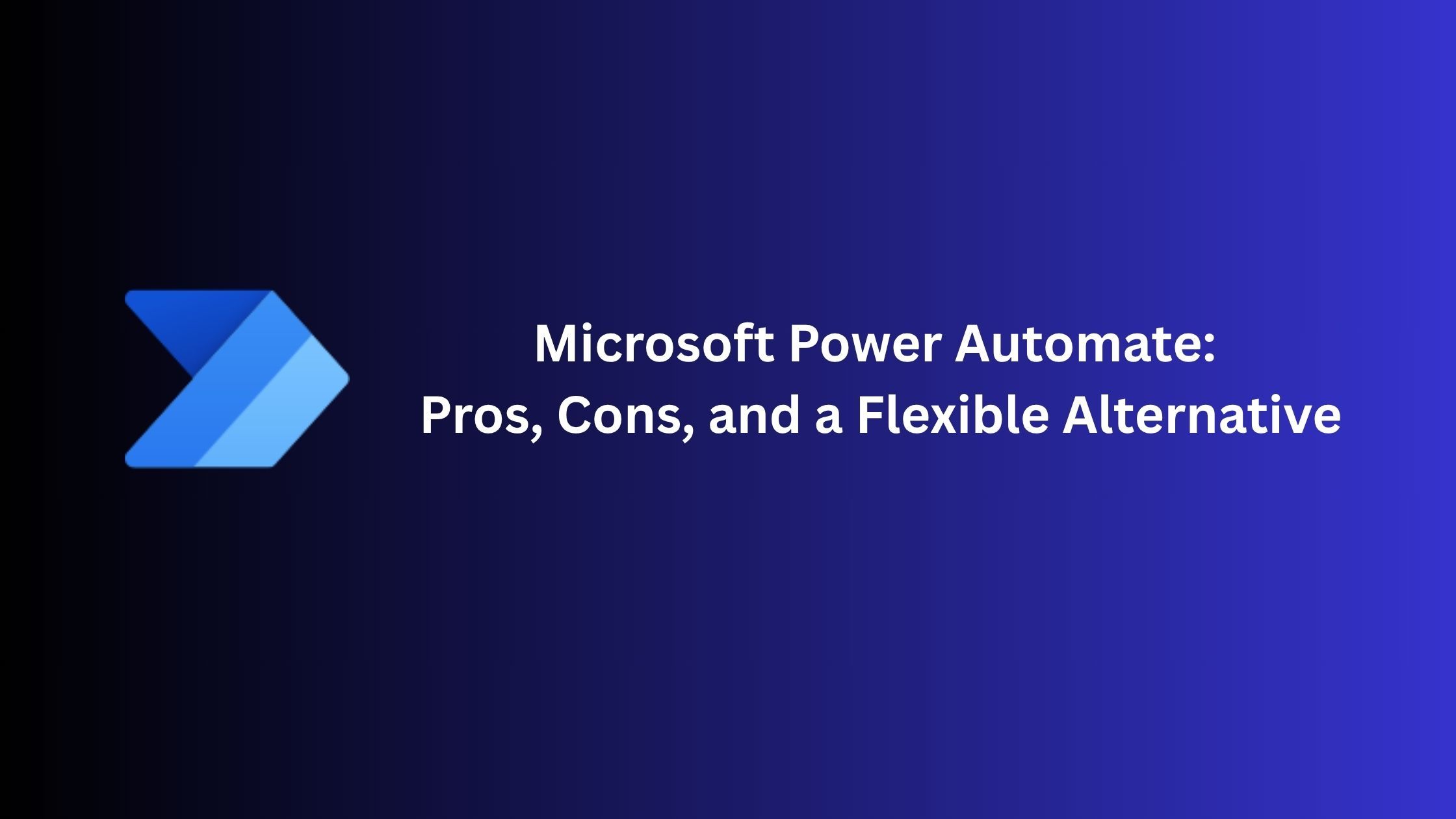Microsoft Power Automate: Pros, Cons, and a Flexible Alternative

Microsoft Power Automate is widely used for building cross-application workflows. In this guide, we take a closer look at its benefits, limitations, and an interesting alternative.
By the end, you’ll have a clear understanding of when you may need Power Automate and when another option might be better
What is Microsoft Power Automate?
Microsoft Power Automate, previously known as Microsoft Flow, is Microsoft’s business process automation software designed to help individuals, teams, and enterprises automate repetitive tasks, streamline workflows, and connect multiple applications. Power Automate is a part of the Microsoft Power Platform.
Unlike basic Microsoft Office automation tools such as Excel macros or Outlook rules, which only handle isolated tasks within a single application, Microsoft Power Automate connects multiple apps and services to create end-to-end workflows across your entire business.
It connects both Microsoft and third-party apps, allowing businesses to centralize processes and reduce manual work.
Examples of common business automation use cases include:
- Document Processing: Automatically routing uploaded files from a shared folder in SharePoint to an approval manager, then moving the approved file into a finalized folder.
- Task Management: Generating new tasks in Microsoft Planner when specific keywords appear in an incoming email.
- Customer Engagement: Sending a personalized email to a lead captured through a form and adding their details into Dynamics 365.
Is Microsoft Power Automate free?
Microsoft Power Automate offers both a free version and paid subscription plans.
The Free Version of Microsoft Power Automate
The free version of Microsoft Power Automate is available to anyone with a Microsoft account, and limited features are also included with some Microsoft 365 subscriptions. This entry-level tier is designed for small-scale or personal automation needs, providing users with a way to explore Microsoft workflows without the need to immediately purchase a license.
With the free version, you can:
- Create and run cloud flows using standard connectors like Outlook, OneDrive, Excel Online, SharePoint, and Teams.
- Access to very limited third-party apps
- Build office automation tasks such as file organization, email notifications, and simple data transfers.
However, the free tier has important limitations:
- Connector Restrictions: Out of the 900+ connectors supported by Power Automate, the free plan only includes apps in the Microsoft ecosystem and very limited third-party apps. This means many powerful integrations are locked behind premium connectors that require a paid plan.
- Usage Limits: Microsoft 365-included access allows around 750 flow runs per month and approximately 6,000 API requests per day. More usage requires upgrading to a paid license.
- Execution Frequency: Flows on the free plan often run in intervals of 15 minutes or longer, which may be too slow for time-sensitive processes.
If you want an alternative with a more open approach and a flat rate, you might want to consider Activepieces
- No Connector Lock-In: You can connect to any app in the Activepieces ecosystem without worrying about premium classifications. Every available piece is open to free users.
- Generous Monthly Allowance: Activepieces offers 1,000 tasks per month, resetting every month.
- No API Request Limits: If an app isn’t already available as a built-in piece, you can still integrate it through an API call, even on the free plan, without being restricted by daily API request caps.
The Paid Versions of Microsoft Power Automate
| Plan Name | Price (USD) | Key Features |
|---|---|---|
| Power Automate Premium | $15 per user/month | - Unlimited cloud and desktop flows (attended RPA) - 5,000 AI Builder credits/month - Access to premium connectors - Process mining and Microsoft Dataverse storage (250 MB DB, 2 GB files) |
| Power Automate Process | $150 per bot/month | - Includes all Premium features - Unattended RPA (flows run without a logged-in user) - Smaller Dataverse storage (50 MB DB, 200 MB files) - Suitable for enterprise bots and shared workflows |
| Power Automate Hosted Process | $215 per bot/month | - Includes all Process features - Microsoft-hosted virtual machines for RPA - Ideal for organizations requiring Microsoft-managed infrastructure |
Add-ons:
- Power Automate Process Mining: $5,000/tenant/month (paid yearly). Discovers, visualizes, and analyzes processes to identify optimization opportunities. Premium plan only. Includes 100 GB data storage, plus Dataverse entitlements (2 GB database, 1 TB file).
- AI Builder Capacity Add-on T1: $500/unit/month (paid yearly). Adds custom or prebuilt AI model capabilities to flows. Available for select Power Automate, Power Apps, and Dynamics 365 paid plans.
- Microsoft Copilot Studio: $200 for 25,000 messages/month (paid yearly). Provides a graphical development environment for building copilots with generative AI, conversational tools, plugins, automation, and built-in analytics.
However, if you want unlimited tasks under a single, predictable price no per-task billing and no separate add-on fees. You can see the full breakdown of Activepieces’ pricing.
What are the benefits of Microsoft Power Automate?
Microsoft Power Automate delivers a range of benefits that make it a valuable addition to modern businesses seeking to improve efficiency, accuracy, and scalability. Some of the benefits include
- Time Savings Through Automation
One of the most immediate benefits of Microsoft Automate is time efficiency. By automating repetitive tasks such as sending reminders, updating records, and moving files, employees can focus on high-value activities that require human judgment.
- Improved Accuracy and Reduced Errors
Manual processes are prone to errors, especially in high-volume data environments. With Microsoft Power Automate, tasks like data entry, document routing, and status updates happen consistently according to predefined rules. This eliminates the risk of skipping steps, entering incorrect data, or forgetting deadlines.
However, alternatives like Activepieces address key challenges that some Power Automate users face:
- Predictable Pricing: Activepieces offers unlimited tasks and AI-powered workflows without forcing upgrades to higher tiers.
- Flexibility in Integrations: Works equally well with Microsoft tools, Google Workspace, CRM platforms, marketing automation software, and hundreds of other apps.
- Beginner-Friendly Interface: Designed to be intuitive for non-technical users while still offering advanced capabilities for developers.
- Self-Hosting Capability : Ideal for businesses that need to keep automation infrastructure in-house for compliance or security. This makes Activepieces especially attractive for organizations in strictly regulated industries.
When Do You Need Microsoft Power Automate?
This depends on the complexity of your workflows, the applications you use daily, and how much value automation can bring to your business.
When Microsoft Power Automate Makes Sense
If your team heavily uses Microsoft 365 apps such as Outlook, Excel, SharePoint, MS Power Apps, and Teams, Power Automate allows you to build Microsoft workflows without worrying about compatibility.
When Microsoft Power Automate Might Not Be the Best Fit
Microsoft Power Automate may not be the most practical option in certain cases:
You want unlimited workflow steps without higher costs
In Power Automate, larger and more complex flows can quickly push you into more expensive pricing tiers.
You need complete self-hosting
Power Automate is cloud-based, which means it is not suited for businesses that require fully on-premises workflow automation for compliance or data control reasons.
If you are not fully tied to the Microsoft ecosystem, or if you need an automation platform that offers more flexibility in pricing and deployment, Activepieces is worth considering.
You can create a free Activepieces account here: https://www.activepieces.com/
Try it and compare with Microsoft Power Automate and know which one works better for your needs.


